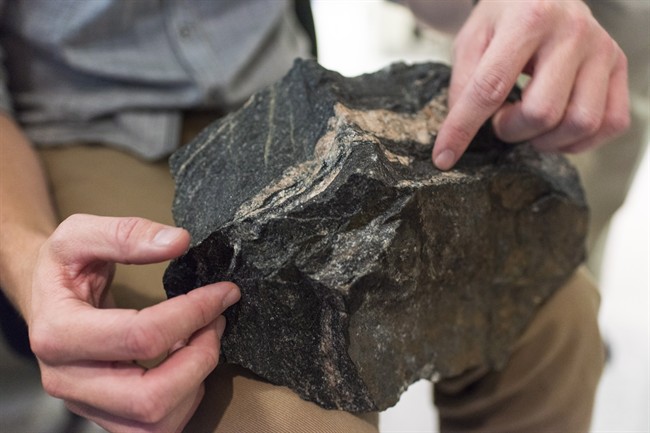EDMONTON – Even a geologist will admit these brownish-grey, fine-grained, indifferently striped rocks look boring.

But a University of Alberta-led team has teased apart the chemistry of these stones from the Northwest Territories to get them to release their exciting secret — a unique glimpse into the Earth’s most distant and mysterious past.
“We actually have more information about the moon during this time period than we do about our own planet,” Jesse Reimink said.
Reimink is one of the authors of a new paper released Monday by Nature Geoscience.
He and his colleagues have peered deeply into rocks from the Acasta Gneiss formation near Yellowknife. At 4.02 billion years old, they’re not quite the oldest ones out there.
But they are the oldest known rocks that still hold the tiny crystals of zircon they had when they were created. And the combination of those rocks and the zircon they came with has opened a tiny window into the so-called Hadean eon, the first 500 million years in the life of the Earth after its creation 4.5 billion years ago.
“The chemistry of the rock is quite unique,” Reimink said. “It looks like something that is quite rare on the modern Earth and we drew an analogy to modern Iceland.”
READ MORE: Toxic dust buried under Yellowknife’s giant mine to cost taxpayers $900M
That’s important for what it suggests about one of the great questions about the Earth’s early past — when did the continents form?
The Acasta geiss was once part of a giant plume of molten rock that pushed its way around the young planet before coming to rest and cooling. As it cooled, it interacted with the even older rock around it — an interaction that left its mark inside those crystals of zircon and the rocks in which they are embedded.
Those marks are clues about what was in those early formations, the very earliest crust of the Earth.
Scientists have previously concluded there are two types of that early crust. One is associated with land and called continental; the other with water and called oceanic. Oceanic crust is generally older than continental.
Interestingly, the Acasta rocks look like they interacted with oceanic crust in the process of turning into continental crust. Think of Iceland, where old rocks are being melted by the area’s volatile geology into new ones.
“Iceland is sort of in between oceanic and continental right now. Iceland has been, for a long time, a theoretical analogy for how continents first formed,” said Reimink. “When we discovered this rock, there’s a lot of chemical signatures in it that are similar to modern Iceland.
“We’re seeing signs of a process that might be different from the process dominant on the modern Earth.”
READ MORE: New species of dinosaur found in Alberta’s badlands
That tiny hint about when and how continents formed may not seem like much. But Reimink says so little remains from the planet’s early days — there are only three places worldwide with rocks from the Hadean eon — that even the weakest flashlight pierces the dark.
“It’s both extremely frustrating and very inspiring,” Reimink said.
“There aren’t very many rocks around and, the ones that are, are difficult to work with.
“But when you’re thinking about things this far back in time, it’s kind of inspiring and fun to think about these problems. It’s kind of fun, when you’re standing on the rock, to think about all the changes that rock has seen.”

Comments